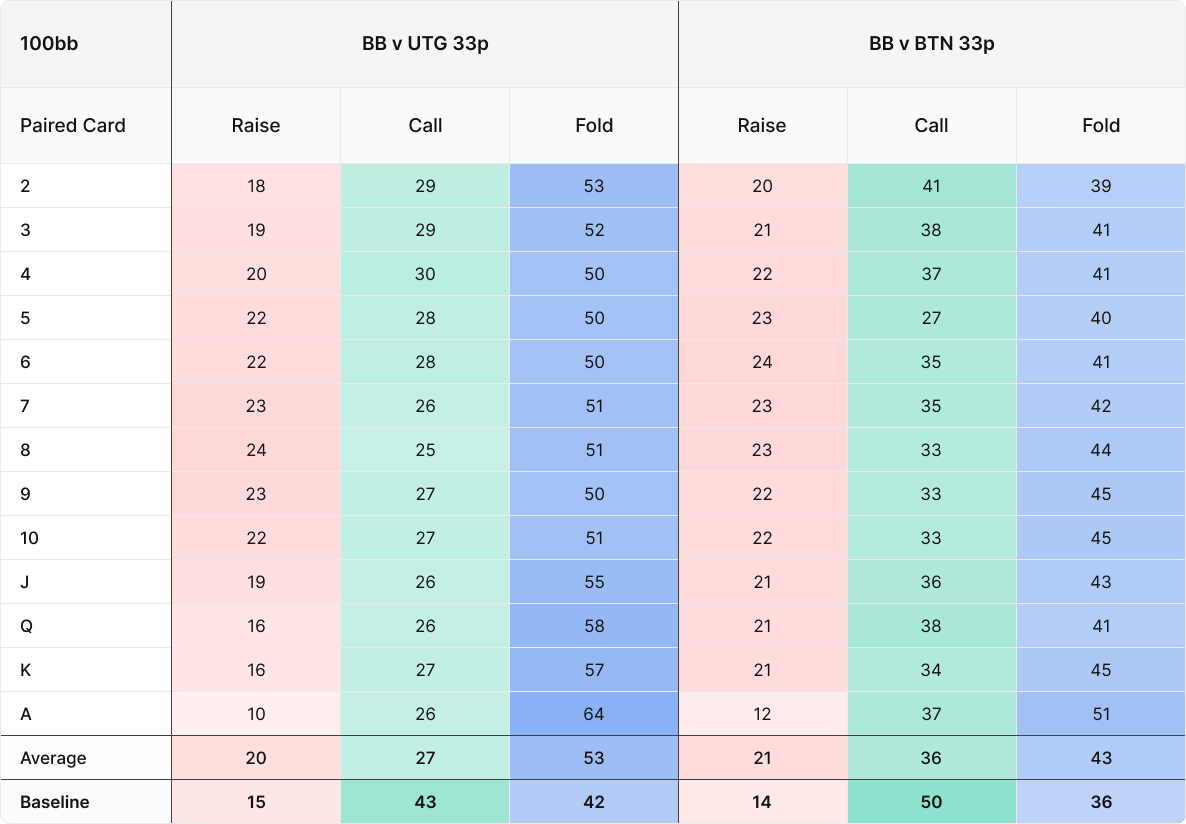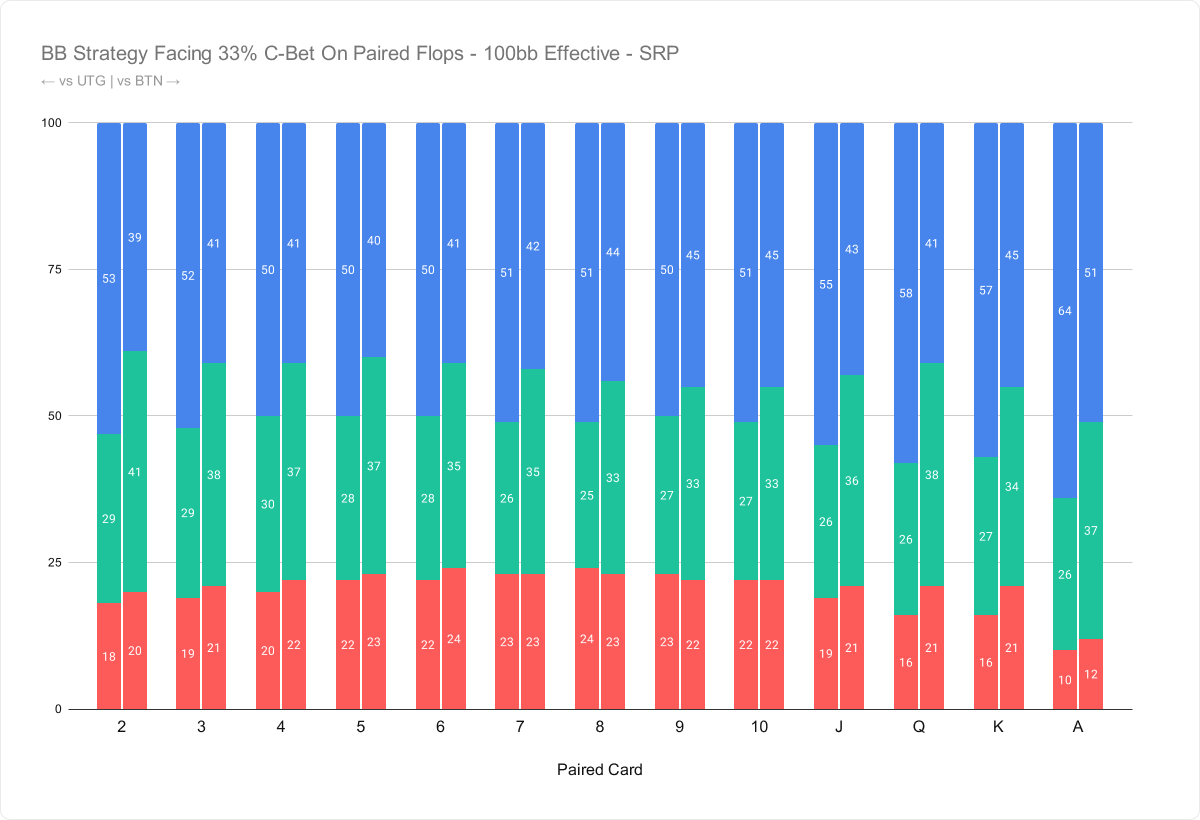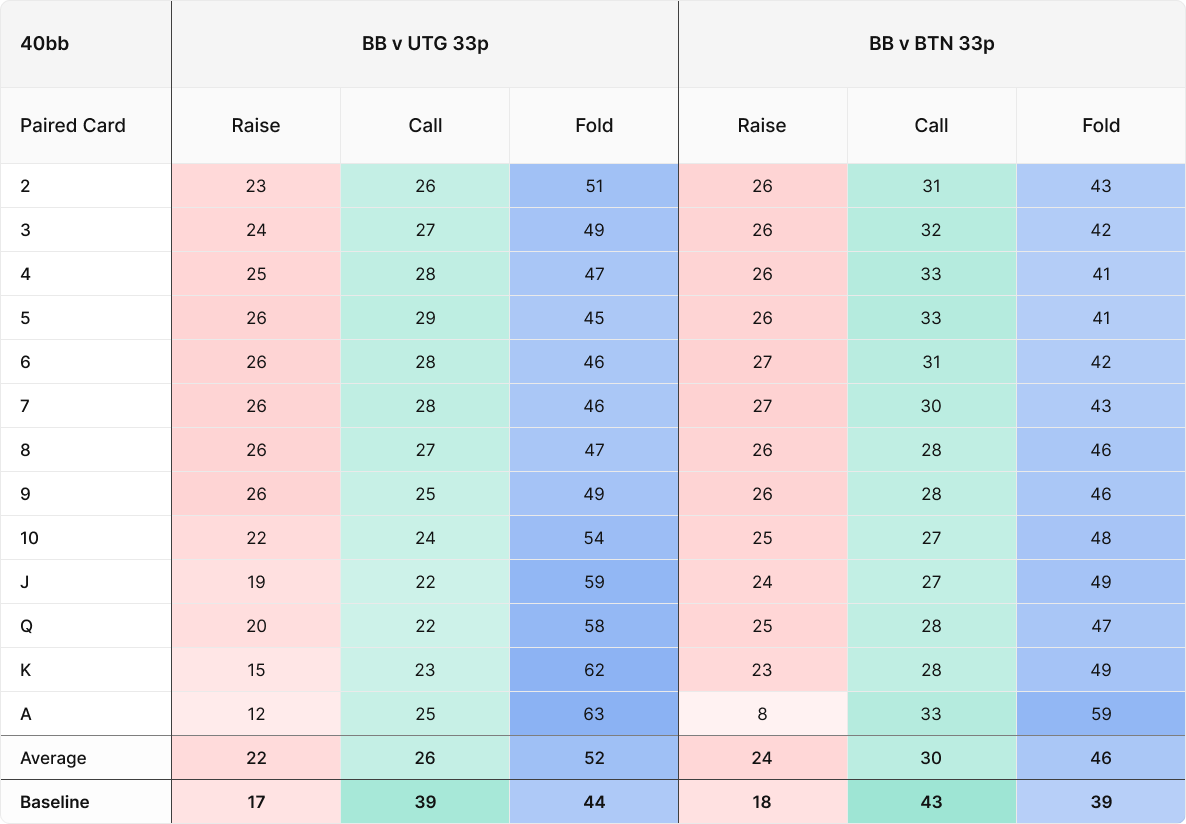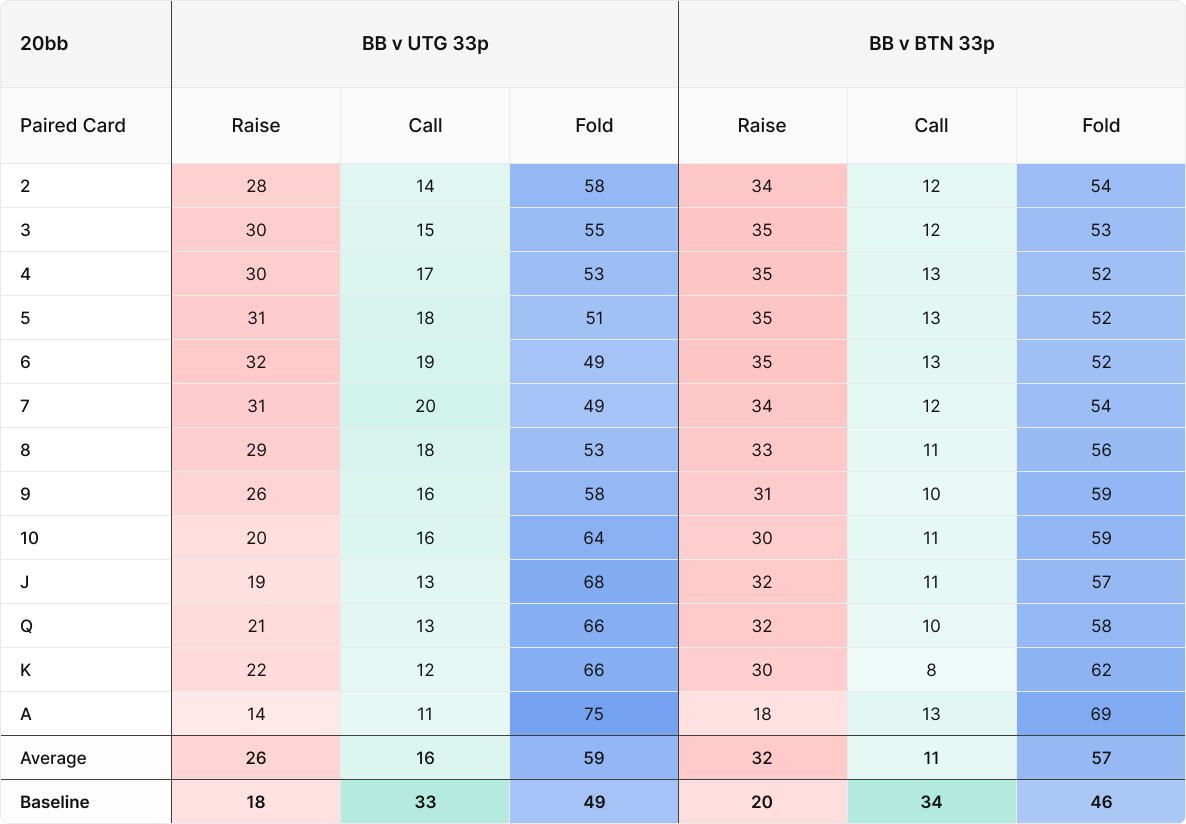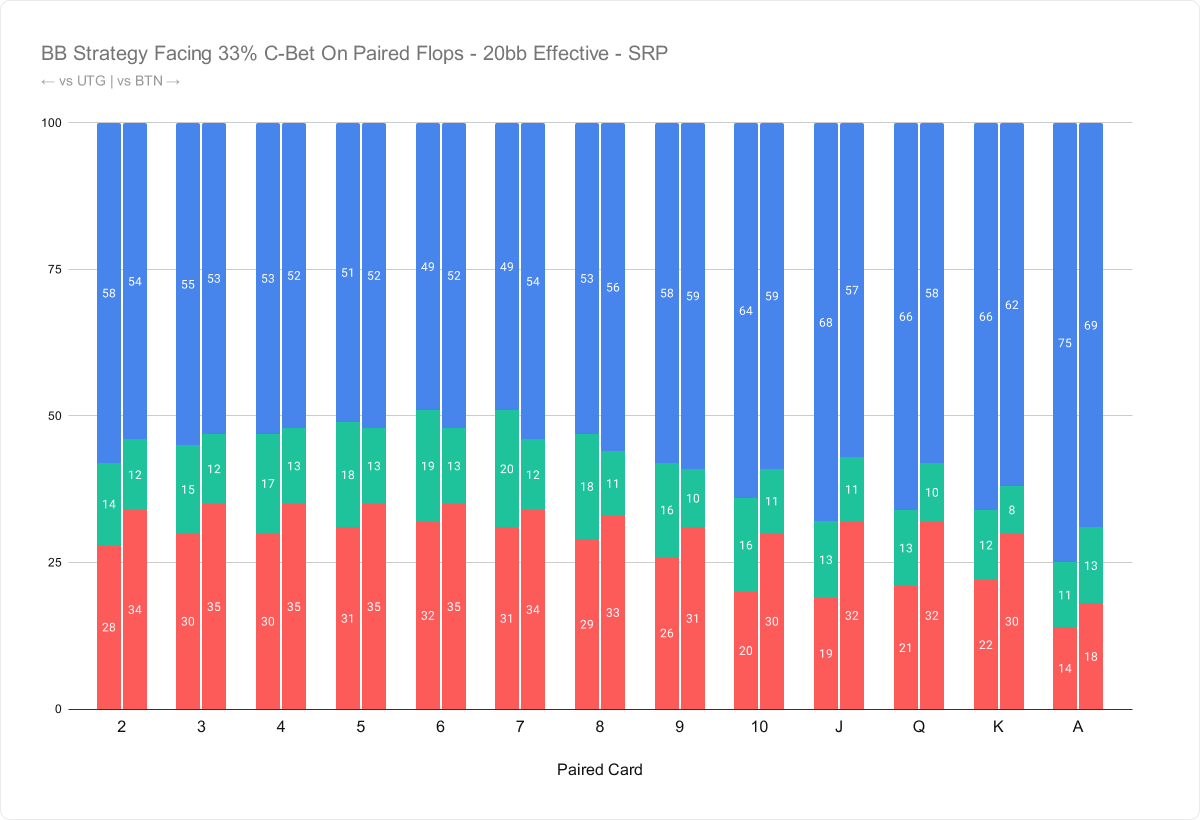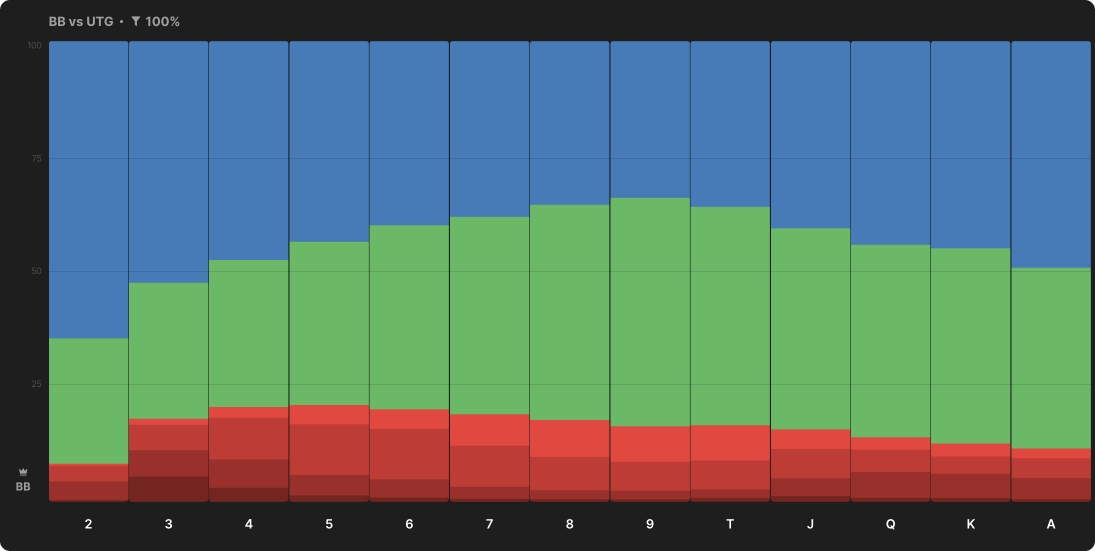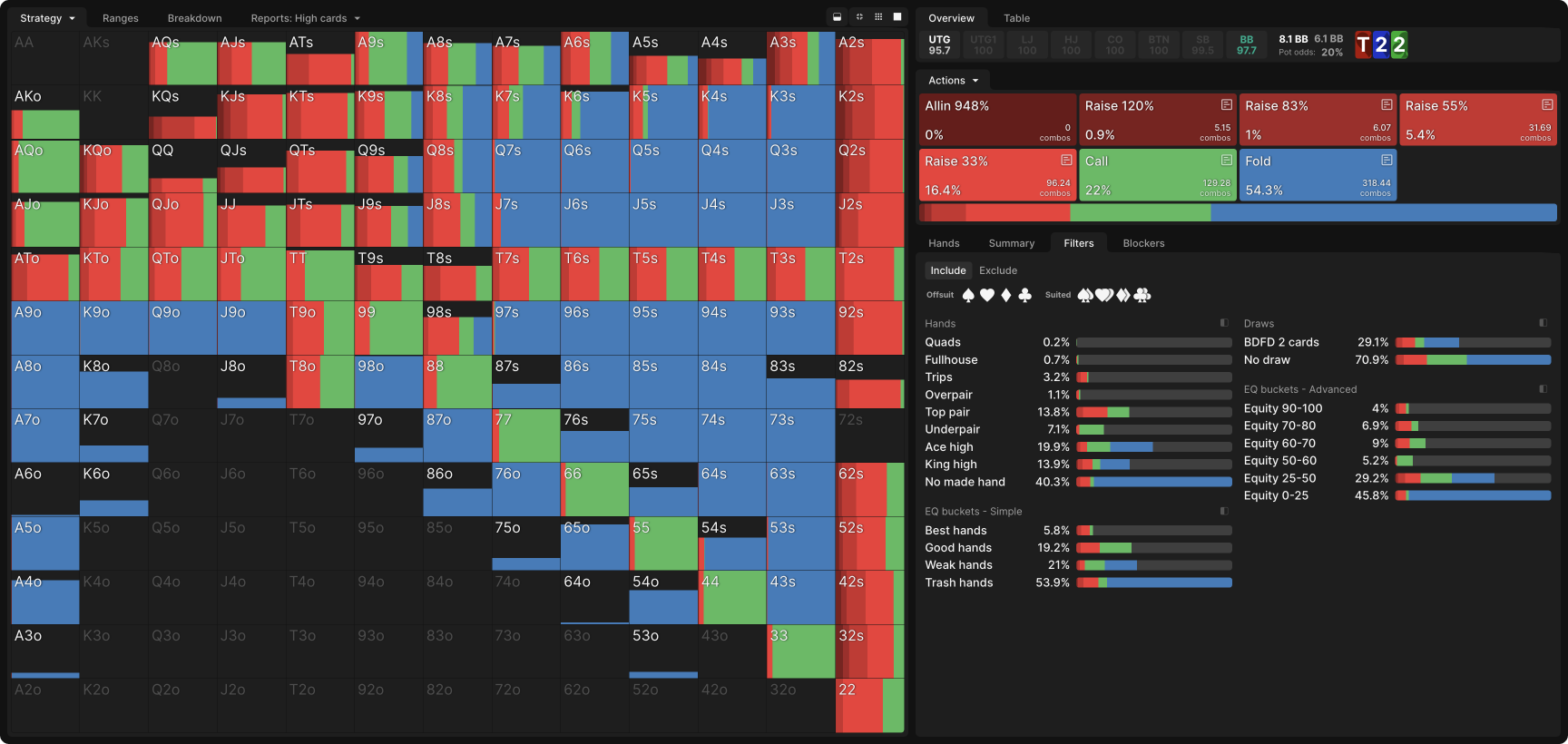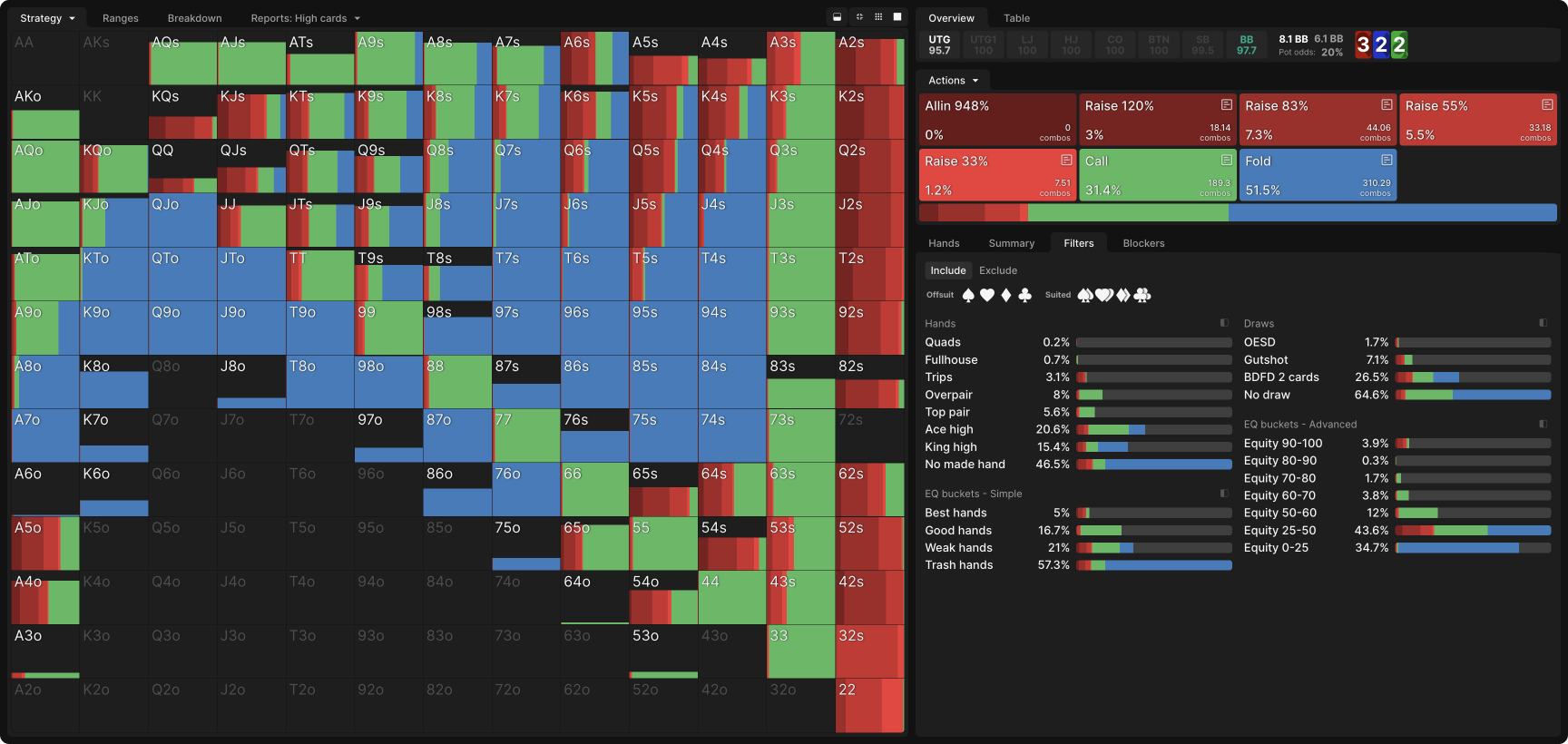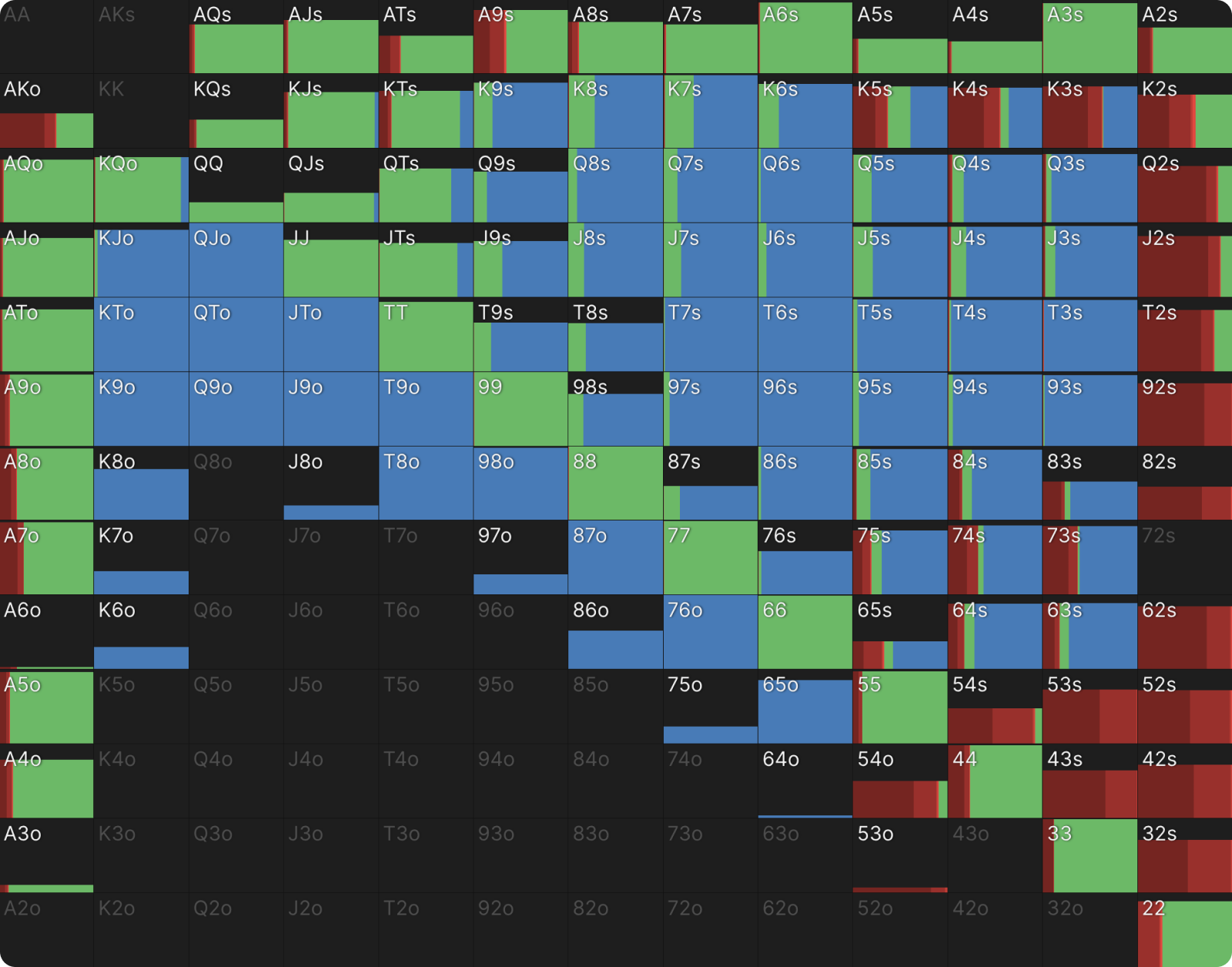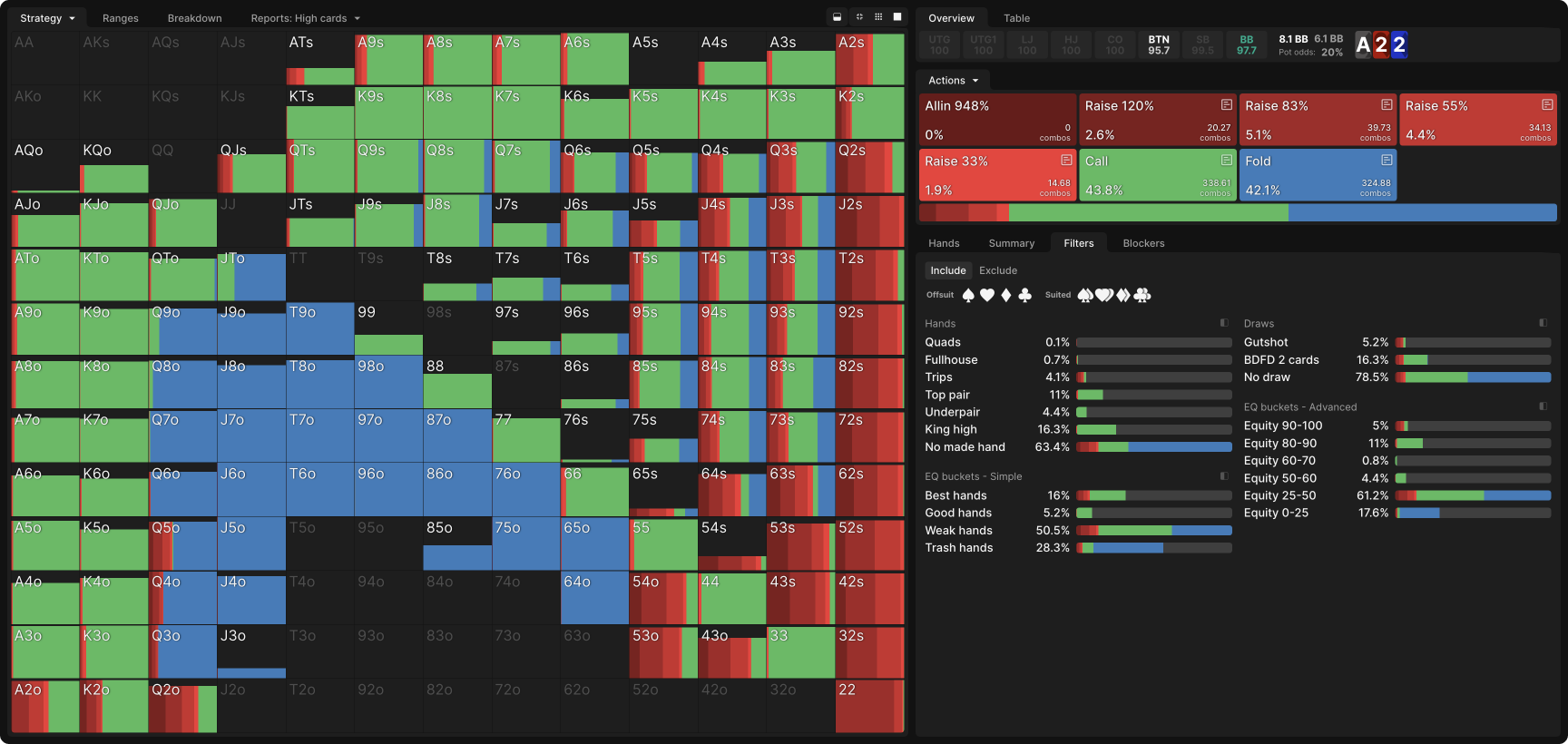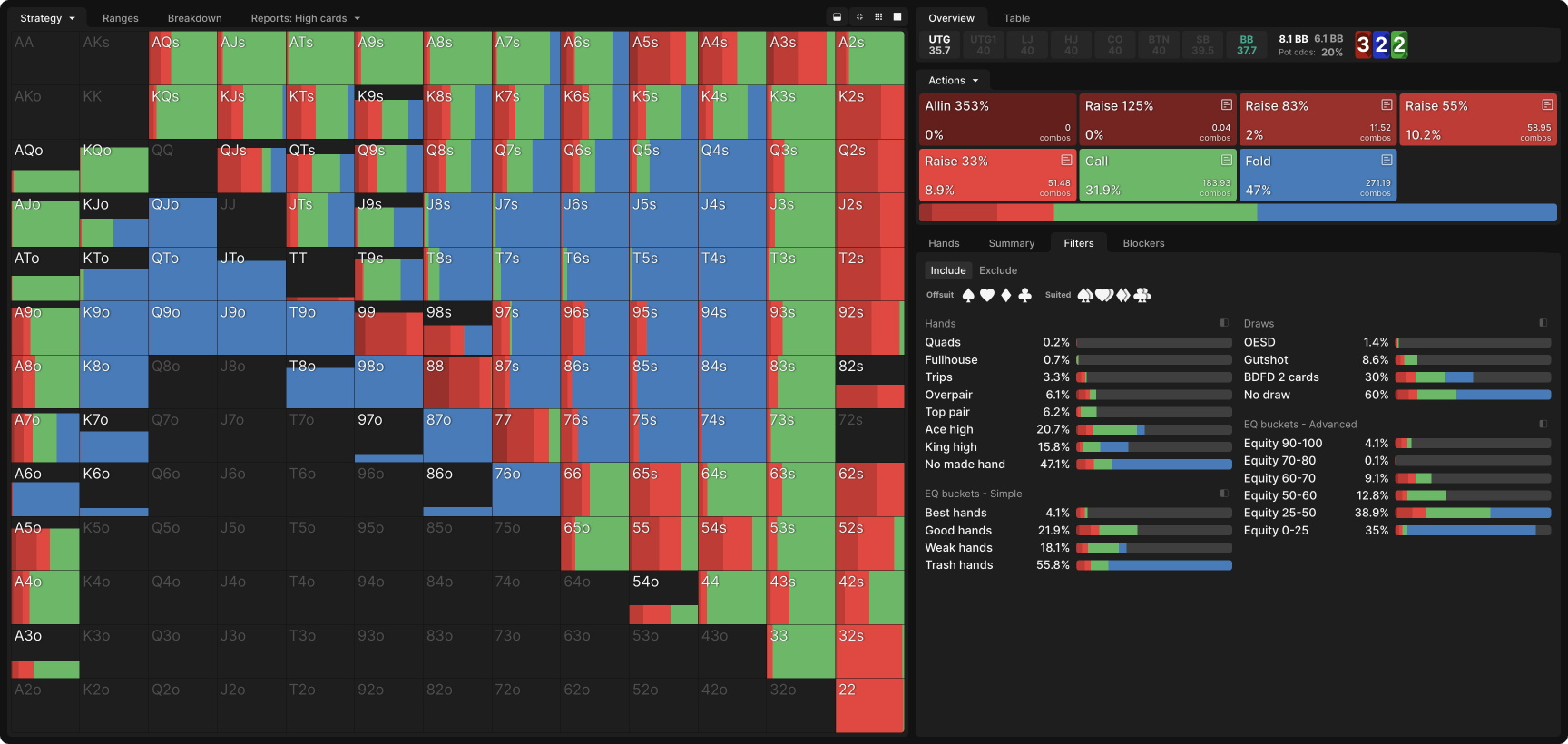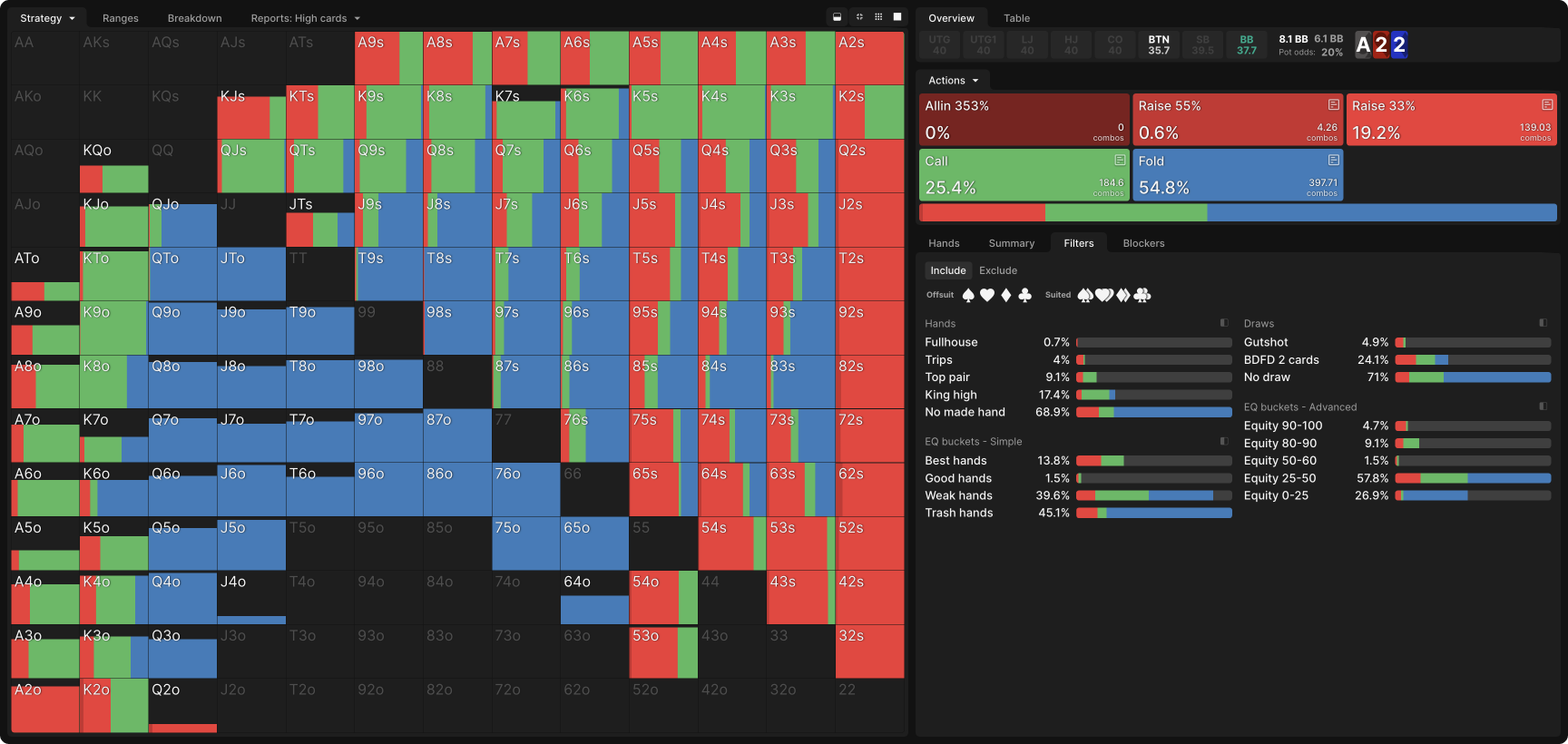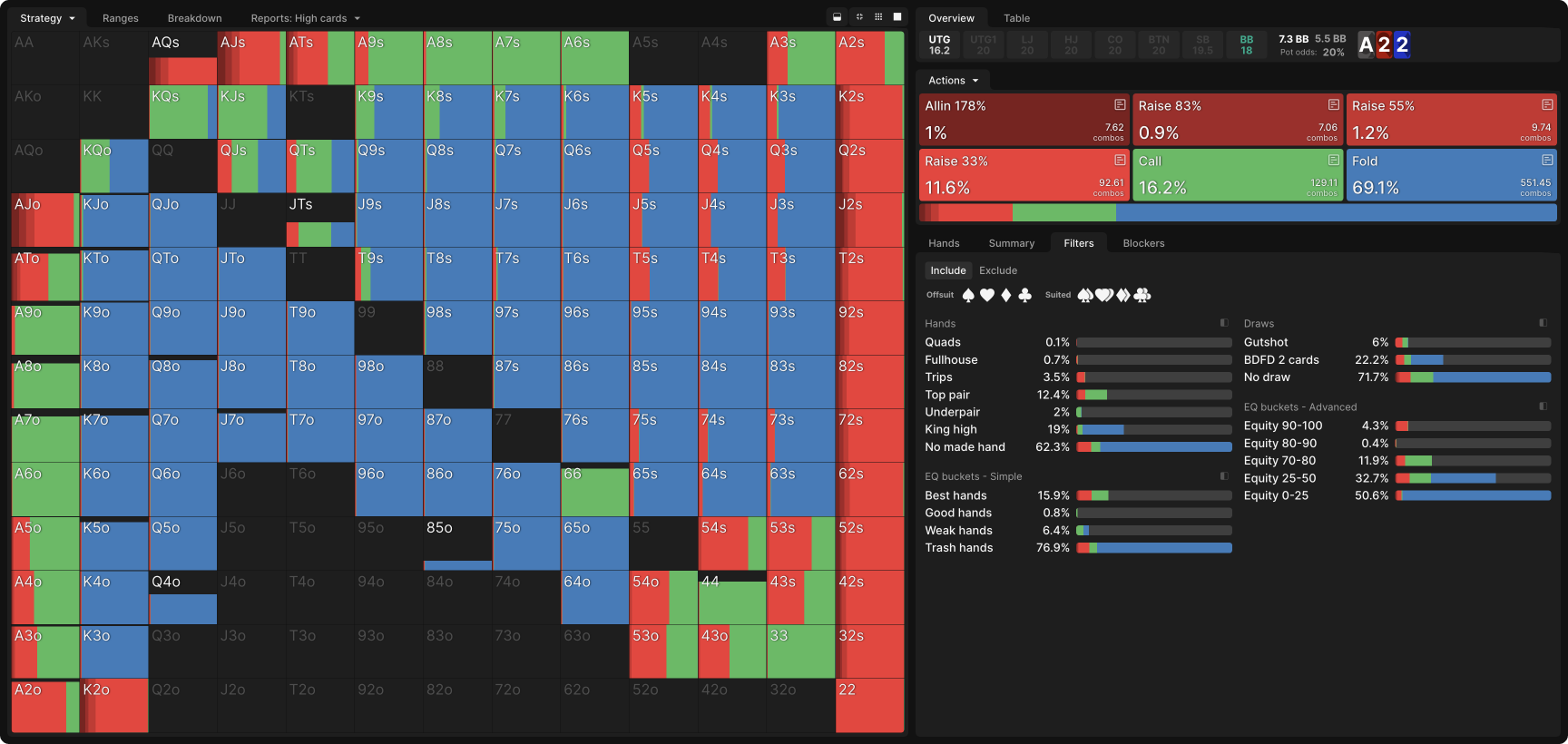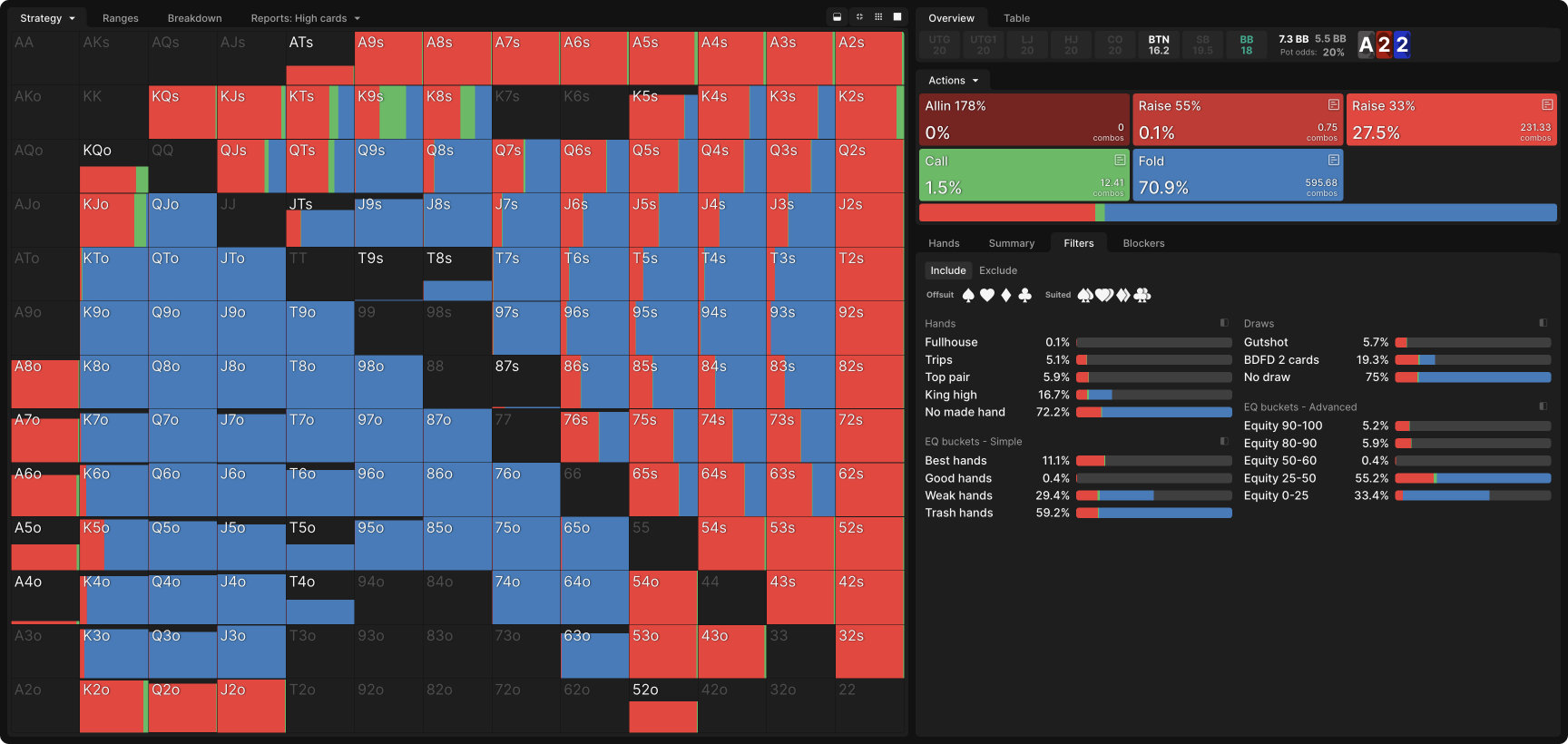Attacking Paired Flops From the BB

Paired flops present unique challenges to both a preflop raiser and a BB caller. The difficulty of flopping pairs or draws forces both players to bet, raise, and call with hands that have no obvious coordination with the board, plays that do not feature prominently in continuation betting and check-raising strategies on other board types.
As we will see, however, “paired flop” is a broad classification that conceals a lot of nuance. The stack depth, the position of the preflop raiser, the size of the pair, and even the size of the third card on the flop all influence optimal strategy in important ways.
The Big Picture
The following chart shows the BB’s response to a 33% pot continuation bet on paired flops, depending on the size of the pair. The bottom two rows show, respectively, the average response across all paired flops and, for a baseline comparison, across all flops.
We can immediately observe a few trends:
- Relative to a random flop, paired flops entail less calling, more raising, and more folding for the BB. This is true regardless of the preflop raiser’s position and, as we will see, regardless of stack depth. Because defending with no pair, no draw is so difficult, BB folds more often, but also raises more often in order to present their opponent with the same dilemma.
- Boards with medium pairs are best for raising. Larger pairs – especially Aces–are worse for raising. This is because BB has more 7s, 6s, and 5s in their range, while broadway cards make up a larger percentage of the raiser’s range. Neither player has many of the smallest cards, so while these board pairs are not as bad for the BB as the big pairs, they are not as good as the medium ones, either.
- BB raises slightly more often against a late position raiser and calls much more often. This reflects the late position raiser’s wider range, against which BB’s many unpaired hands are more likely to be live.
Shallower Stacks
Comparison to 40bb scenarios, depicted in the chart below, reveals similar trends and some important differences:
At 40bb, BB check-raises paired flops somewhat more aggressively in general, especially the lower card flops that were not so good for check-raising at 100bb, but check-raises dramatically less against the BTN on AAx flops. This reflects differences in BB’s preflop calling range. Shallower stacks make for better equity realization when out of position, enabling BB to call preflop with somewhat weaker hands and thus to flop trips more often on low card boards. However, they are more likely to three-bet their Ax against a BTN open, making it harder to flop (or represent) trips on AAx flops.
With a low SPR, the question of who has more trips becomes less relevant, as any pair and even some unpaired hands can be strong enough to stack off with.
These differences are even more dramatic at 20bb, where the BB’s strategy involves considerably more raising. With a low SPR, the question of who has more trips becomes less relevant, as any pair and even some unpaired hands can be strong enough to stack off with.
BB also folds more often with shallow stacks, but this mostly represents an important difference in the preflop action. Unlike at 40bb and 100bb, BTN’s preflop raise at 20bb is to just 2bb, incentivizing BB to call with more weak hands. Thus, they have more weak hands to fold on the flop.
Which Hands Check-Raise?
The charts above lump together raises of all sizes. When we break down the strategy by raise size, some new patterns emerge, providing insight into which kinds of hands raise and why. Here is the BB’s strategy vs an UTG 33% pot continuation bet on X22 flops, 100bb deep. The numbers on the x-axis represent the third card, so the column on the far left is 222 flops, the next one is 322, etc., all the way up to A22 on the far right.
When the third card is a 5 through T, BB prefers smaller raises. For the lowest and highest third cards, they use more large raises. This reflects the desirability of check-raising when they pair that third card.
On a T22 flop, BB can check-raise even a modest kicker like T9 to simultaneously deny equity to overcards and get value from lower pocket pairs. Check-raising 93 on a 322 flop, however, would result in value cutting themselves against those same pocket pairs. And on a K22 flop, denying equity is less of a factor, as there is no opportunity to push UTG off two overcards.
Here’s the full strategy for responding to a 33% pot continuation bet on T22r. Notice how BB check-raises a pair of Ts more often than they call them:
Hands like T9 benefit from folds and have reasonable equity when called, because of the lower pocket pairs in UTG’s range. The only thing they fear is a three-bet. Fortunately, the risk of running into trips, which BB almost always check-raises, discourages UTG from three-betting.
The larger BB raises, the more UTG’s calling range will be concentrated around hands that dominate these weaker broadway cards, which reduces the value of turning top pair after raising.
BB rounds out their check-raising range with overcards and backdoor flush draws. On a disconnected rainbow flop, these are the highest equity draws available, the hands with the best chance of drawing out when called by a T or a pocket pair. Note that the lower broadway cards are pure check-raises, while the higher ones mostly call. AK and AQ, which could easily be ahead already, value fold equity much less than QJ, which can make not just better hands but dominating hands fold, cleaning up their equity for turning pairs.
A smaller size suits this range well. The protection raises get most of the folds they want even with a small raise, and they welcome the lighter calls the small raise entices. Hands like QJ and KJ would prefer folds, but they don’t mind inducing calls since they have a fair chance of drawing out. And they do benefit from keeping their risk low when they run into the strongest part of UTG’s range. The larger BB raises, the more UTG’s calling range will be concentrated around hands that dominate these weaker broadway cards, which reduces the value of turning top pair after raising.
BB’s strategy looks quite different on 322r:
They mostly call their 3x, making exceptions only for backdoor straight draws and the strongest kickers. When they do raise, it’s a more polar range consisting mainly of trips for value and many weaker bluff candidates such as a single big card with multiple backdoor draws. Trips, of course, are happy to make the pot as large as they can, and the weaker bluffs are happy to get as many folds as possible, since their equity against the top of UTG’s range is not that much worse than their equity against the middling hands that would be more price-sensitive.
The most extreme example of this is A22r, where those smaller check-raises drop out entirely, and BB’s raising range is almost exclusively trips and low-equity bluffs such as gutshots and backdoor draws:
BB’s raises on the same flop are similar against BTN but the sizes are a bit smaller. This is because BTN has more trips in their range than UTG, so BB must raise a bit smaller to target UTG’s one pair hands.
The biggest difference between BB’s response to BTN as opposed to UTG is more calling. Against a BTN opener, calling with King-high and even Queen-high is viable.
These patterns reveal themselves most clearly when the board pair is low, as neither player is especially likely to have trips (though the BB is more likely). We have already seen that BB raises less in general when the board pair is higher. They also use smaller sizes, on average, as the risk of running into trips from the preflop raiser is higher.
But the same principles hold even on higher paired boards. Here’s BB’s response ton a 33% pot bet from UTG when 100bb deep on QQ7r. They raise a bit less often than on T22r, but they raise the same kinds of hands: trips, 7x, occasional lower pairs, and two big cards with backdoor draws:
Medium Stacks
With 40bb stacks stacks, BB’s strategy vs UTG on 322r starts to resemble T22r, with more small, thin value raises. A small raise with trips is less of a sacrifice, as they can get stacks in by the river regardless. Top pair still mostly calls, but there is more room to check-raise medium pocket pairs:
Going from 100bb to 40bb does not change BB’s A22r strategy so dramatically. Their raise size comes down, but that’s mostly because they no longer need to raise so large to get stacks in with trips. There’s a little more raising from top pair, but their range is still polarized to mostly trips and low-equity bluffs:
Shallow Stacks
With 20bb, BB does far more thin value/protection raising, even against UTG. The low SPR enables them to treat even a 3 with a bad kicker as the nuts and on 322r. Their strategy on this flop looks almost identical to the 722r with deeper stacks, featuring many small raises from a pair-heavy range. BB even slowplays some trips now that building the pot is no longer a concern:
BB’s strategy vs UTG on A22r remains largely unchanged, however:
Facing a BTN raiser on the same board is a different story. BB’s raising range is actually still polar, even though it’s much wider:
Thanks to BTN’s wider range and the fact that BB had a lot of incentive to shove Ax and pocket pairs preflop, BB can raise all their Ax for value, balancing those raises with many bluffs. In fact, they have no good candidates for calling! All their hands are either strong enough to raise for value or so weak they must rely on fold equity.
Conclusion
BB’s response to a continuation bet on paired flops varies with the stack depth, position of the preflop raiser, rank of the pair on the board, and rank of the unpaired board card. It always involves more raising and more folding than on the average flop, but the composition of that raising range can change dramatically with the circumstances.
At one extreme are circumstances where the preflop raiser enjoys an especially large range advantage, which is usually when they are in early position and one or both board cards are highly ranked. In these cases, BB mostly raises trips and low equity bluffs for a large size.
As stacks get shallower, it becomes easier for BB to check-raise for thin value. Slowplaying trips becomes more appealing with a lower SPR as well.
At the other extreme are boards where the preflop raiser’s range consists of many unpaired hands and contains several pocket pairs below the unpaired board card. This occurs more commonly when the raiser is in late position but can arise even against an UTG raiser on an especially dry flop like T22r. In these cases, BB raises a less polar range consisting of higher equity bluffs, and thin value/protection raises from medium pairs. They also include most of their trips in this range, making it difficult for their opponent to three-bet them.
Author
Andrew Brokos
Andrew Brokos has been a professional poker player, coach, and author for over 15 years. He co-hosts the Thinking Poker Podcast and is the author of the Play Optimal Poker books, among others.
